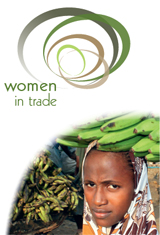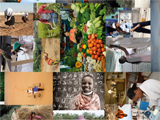
Celebrating the 2013 International Women’s Day
The WTO joins the world in celebrating International Women's Day on 8 March 2013, to honour women around the world and their economic, political and social achievements. Trade can empower women and contribute to reducing poverty and fostering development. More needs to be done to help women benefit from trade.
See also:
> International Women's Day web site
Trade is a powerful engine to foster growth, generate jobs and reduce poverty. Trade is also a tool to empower women. According to the ILO trade is the most important source of employment among self-employed women of Sub-Saharan Africa providing 60% of non-agricultural self-employment. Facilitating trade by businesswomen can contribute to achieving the Millennium Development Goals (MDGs). Women continue to bear a disproportionate burden of poverty, and empowering women has multiplier effects for economic growth.
But as we celebrate 2013 International Women's Day, it is important to recognise that still too many women face a disproportionate lack of access to the resources and opportunities to trade and the means to leverage them. They often have limited understanding of buyer requirements and limited capacity to meet requirements. Access to credit is often a challenge. Furthermore, the low visibility of women entrepreneurs, particularly in many poorer countries, hinders potential buyers from understanding the issues, benefits, and opportunities to integrate women in their supply chains, as well as from fulfilling existing commitments to increase sourcing from women under supplier diversity programmes.
Participation in supply chains
Public and private sector procurement markets can provide an important avenue through which women entrepreneurs can increase their exports and income through trade. Despite their significant participation in the economy, according to the World Bank Enterprise Surveys, over 35% of firms worldwide have female participation in ownership; their share of corporate procurement is estimated at less than 1%, and even in the US where there is a government-wide mandated procurement goal of 5%, in 2011 only 3.9 % of contracts were awarded to Women Business Enterprises. More can be done to address the situation.
The WTO's sister agency, the International Trade Centre (ITC) has developed a set of programmes to help women trade more and better. Its “Women and Trade” programme has led to the establishment of a Global Platform for Action on Sourcing from Women Vendors (Global Platform), a framework and support for women entrepreneurs to sell into global supply chains. It has resulted in increased revenues for women-owned businesses and generated new sales worth over US$20 million. The ITC's annual Women Vendors Exhibition and Forum, has enabled women entrepreneurs to participate in face to face meetings with buyers to establish relationships and generate business opportunities. Through the ITC's action, over 2,000 women in specific sectors (coffee in East and West Africa, garments and jewellery in Latin America) have also been linked to export value chains with reported increases in income, expansion of enterprises and job growth. (ITC Women and Trade website)
The WTO is also a partner agency of the Enhanced Integrated Framework (EIF) which is helping Least Developed Countries (LDCs) mainstream gender into national and sector export strategies and establish processes to diagnose and implement gender mainstreaming in trade related projects. (WTO EIF website)
Also, did you know that:
- In West and Central Africa, women informal cross border traders “employ 1.2 people in their home businesses; support on average 3.2 children as well as 3.1 dependants who were not children or spouses.
- A girl is much more likely to go to school if she lives in a city — in developing countries, school attendance for girls from 10 to 14 is 18 per cent higher in urban than in rural areas, and 37 per cent higher for young women between 15 and 19.
- If the work opportunities for young women were equal to their education or capacities – the average household income would grow. If women’s labour force participation had increased at the same rate as education during the 1990s in the Middle East and North Africa, the average household income would have been higher by 25 per cent.
- Young women who are economically empowered in decent, secure work or successful small businesses, and who enjoy equal rights to property and land ownership, are better equipped to create a solid future for themselves, their families and communities.
- Studies have shown that there is high correlation between an increase in gender equality and (a) corporate profitability, (b) per capita GDP and (c) a country’s economic growth.
- From the ITC Women in Trade Programme, globalisation and trade have played a critical role in reducing barriers to achieving greater gender equality. Evidence shows a strong correlation between increased international trade and increases in female employment; trade results in greater employment in exports, increased connection to markets and often higher wages in export oriented industries particularly for women.
- Business women now make up 51% of management professionals and 15% of Fortune 500 corporate officers In developed economies around the world, women produce nearly 40% of official gross domestic product (GDP).
- Women own 1% of the world’s wealth, have a 10% share in global income, and occupy 14% of leadership positions in the private and public sectors.
Source:
Case stories submitted to the WTO for the 3rd Global Review of Aid for Trade in 2011.
See also:
World Trade Organization:
> International Women's Day 2012
> International Women's Day 2011
International Trade Centre (ITC):
